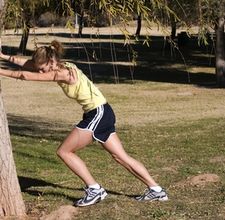
What is Achilles Tendonitis?
The Achilles tendon is a band of tissue that connects the heel bone
to the calf muscle of the leg. Injury to the tendon may cause it to
become inflamed or torn.
Achilles tendonitis is the term used when the
tendon is inflamed. The inflammation causes pain at the back of your leg
near the heel. A tear of the tendon is called a rupture. It also causes
pain near your heel.
How does Achilles Tendonitis occur?
Achilles tendonitis can be caused by:
- Overuse of the Achilles tendon.
- Tight calf muscles.
- Tight Achilles tendons.
- Lots of uphill running.
- Increasing the amount or intensity of sports training, sometimes
along with switching to racing flats, which are racing shoes with less
heel lift.
- Over-pronation, a problem where your feet roll inward and flatten out more than normal when you walk or run.
- Wearing high heels at work and then switching to lower- heeled shoes for exercise.
- An Achilles tendon may tear during sudden activity. For example the tendon might tear when you jump or start sprinting.
Symptoms of Achilles Tendonitis:
- Pain on the tendon during exercise.
- Swelling over the Achilles tendon.
- Redness over the skin.
- You can sometimes feel a creaking when you press your fingers into the tendon and move the foot.
- Pain and stiffness in the Achilles tendon especially in the morning.
- Pain in the tendon when walking especially up hill or up stairs.
- Chronic tendinitis differs from acute tendinitis in that it is more of a long term persistent problem.
Treatment for Achilles Tendonitis:
- Rest and apply cold therapy R.I.C.E.(Rest , Ice , Compression , Elevation)
- Put your lower leg on a pillow when you are lying down.
- Wear a heel pad to raise the heel and take some of the strain off the achilles tendon.
- Take anti-inflammatory medication as prescribed by your health care provider.
- See a sports injury professional who can advise on treatment and rehabilitation.
- In some severe cases of Achilles tendonitis, your foot may be put in a cast for several weeks.
- A tear of the tendon may require surgery. Or your foot may be put in a cast for 6 to 10 weeks.
When can I return to my sport or activity?
The goal of rehabilitation is to return you to your sport or activity
as soon as is safely possible. If you return too soon you may worsen
your injury, which could lead to permanent damage. Everyone recovers
from injury at a different rate. Return to your activity is determined
by how soon your Achilles tendon area recovers, not by how many days or
weeks it has been since your injury occurred. In general, the longer you
have symptoms before you start treatment, the longer it will take to
get better.
You may safely return to your sport or activity when, starting from
the top of the list and progressing to the end, each of the following is
true:
- You have full range of motion in the injured leg compared to the uninjured leg.
- You have full strength of the injured leg compared to the uninjured leg.
- You can jog straight ahead without pain or limping.
- You can sprint straight ahead without pain or limping.
- You can jump on both legs without pain and you can jump on the injured leg without pain.
Prevention of Achilles Tendonitis:
The best way to prevent achilles tendonitis injury is to
stretch your calf muscles and Achilles tendons before exercise. If you
have tight Achilles tendons or calf muscles, stretch them twice a day
whether or not you are doing any sports activities that day.
If you have a tendency to get Achilles tendonitis, avoid running uphill a lot.
Your Sports Injury Therapist or Doctor could :
- Prescribe anti-inflammatory medication.
- Identify the causes and prescribe orthotics or a change in training methods.
- Tape the back of the leg to support the tendon.
- Apply a plaster cast if it is really bad.
- Use ultrasound treatment.
- Apply sports massage techniques.
- Prescribe a rehabilitation program.
- Some might give a steroid injection however an injection directly
into the tendon is not recommended. Some specialists believe this can
increase the risk of a total rupture.
- Scan with an MRI or Ultrasound - see latest research for more info.
| 

